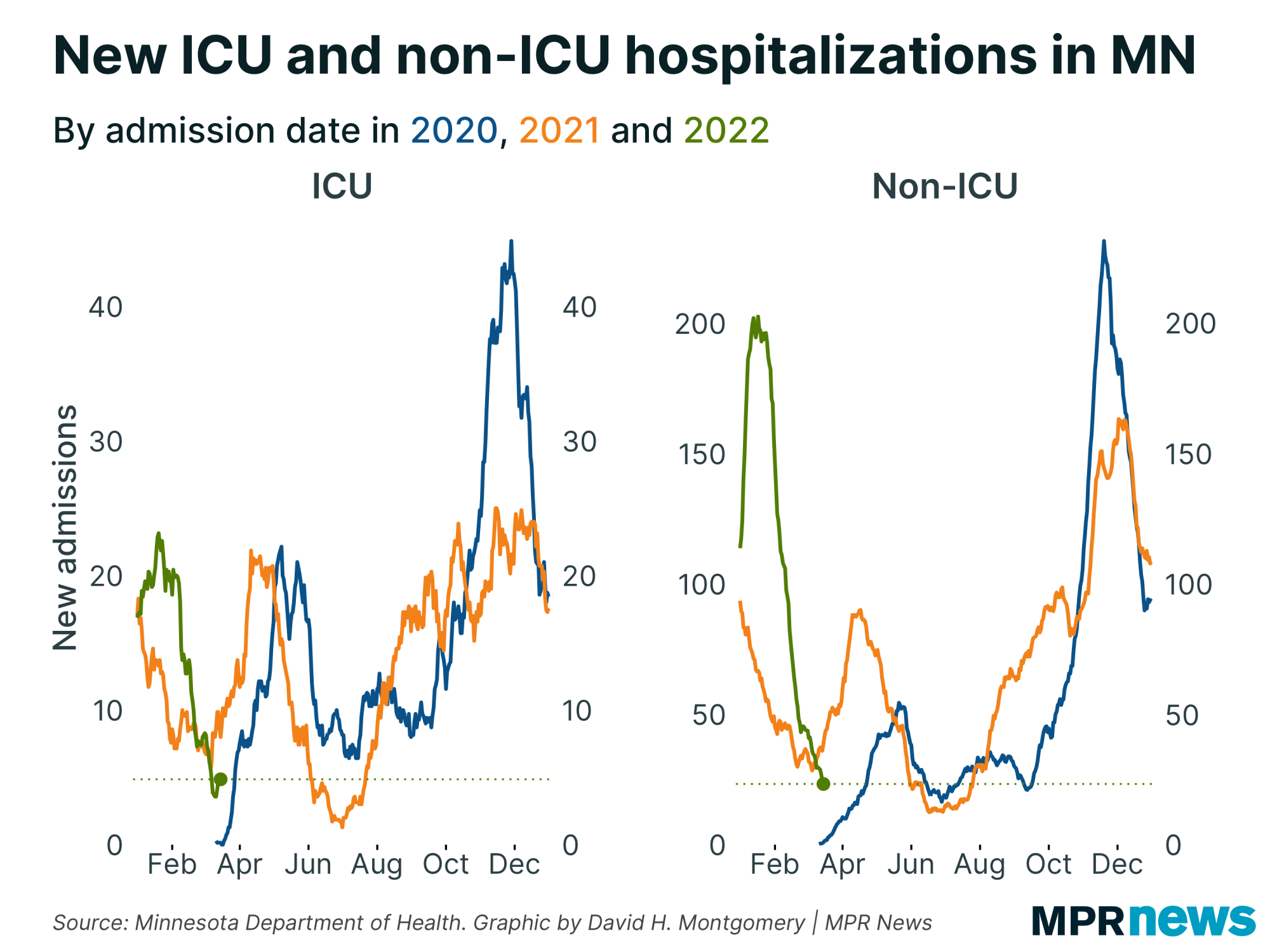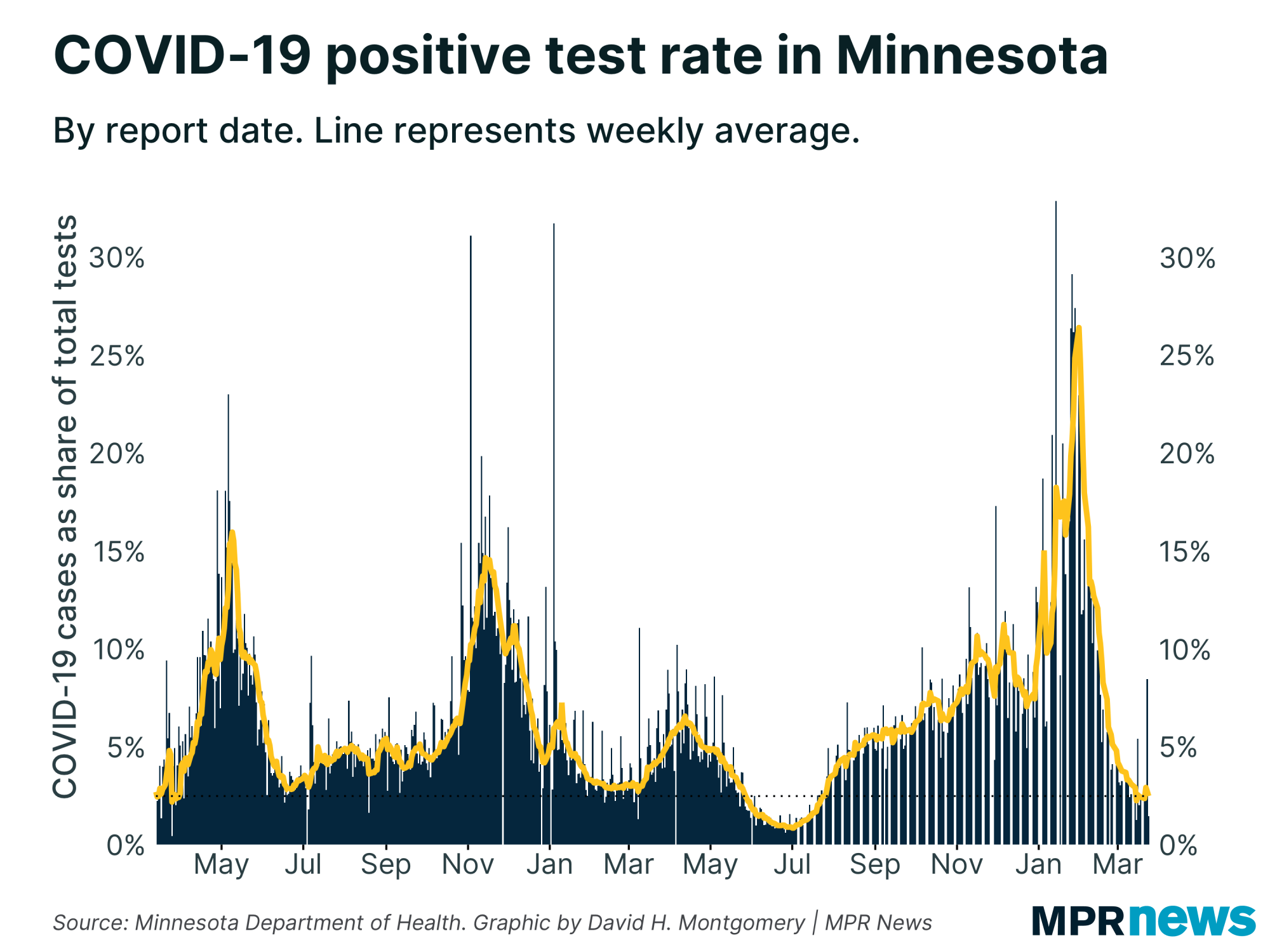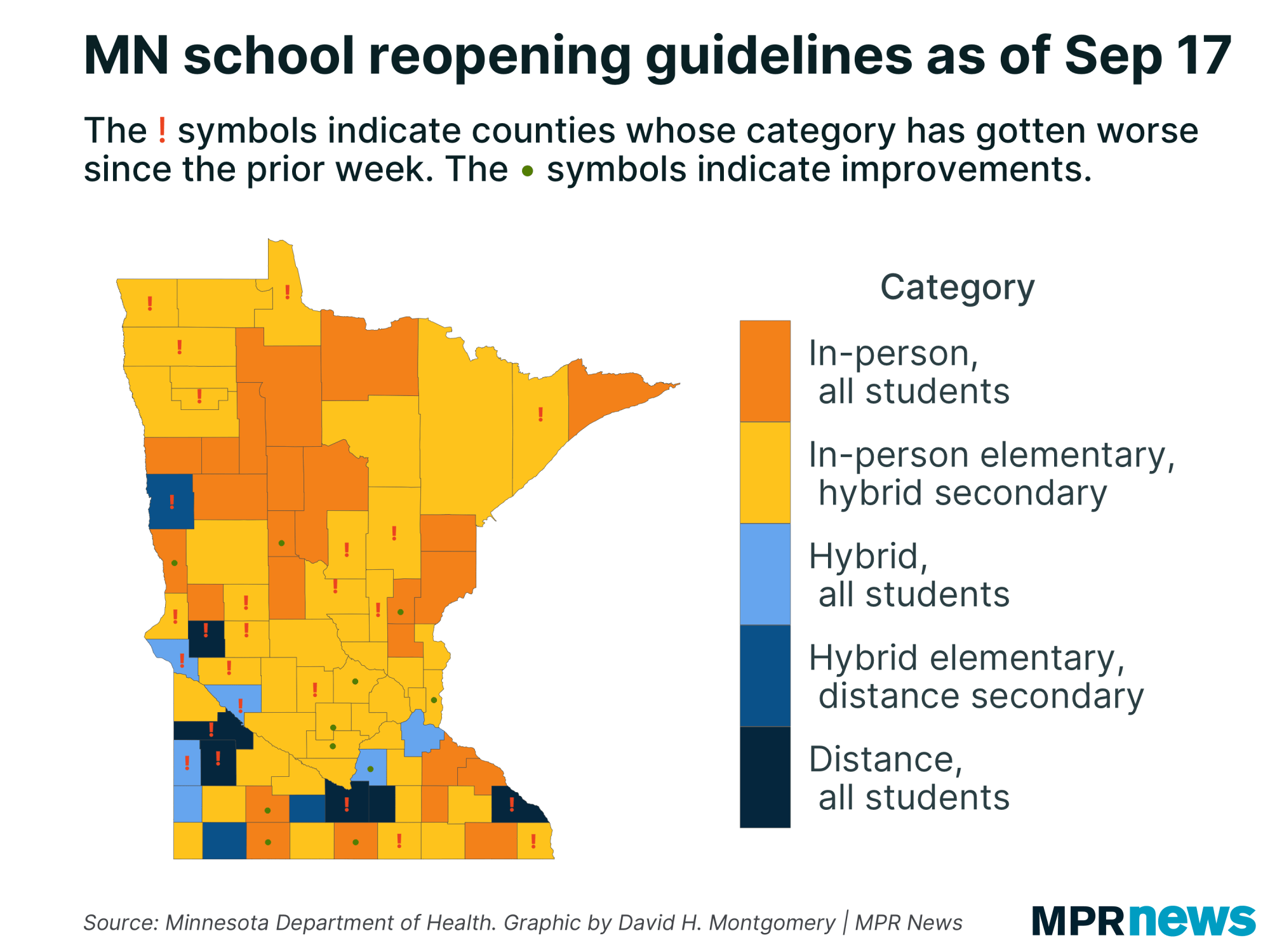Latest on COVID-19 in MN: Record number of new cases as death toll passes 2,000

Go Deeper.
Create an account or log in to save stories.
Like this?
Thanks for liking this story! We have added it to a list of your favorite stories.
Updated 11:25 a.m.
Minnesota health officials reported a record daily increase in COVID-19 cases on Saturday, as the state also passed the grim milestone of 2,000 COVID-19 deaths.
The latest update from the state health department showed 1,478 newly confirmed cases in Minnesota — while the number of reported test results also increased to more than 30,000, among the highest single-day totals on record.
The overall death toll from the pandemic in Minnesota now stands at 2,004. The 10 newly reported deaths on Saturday included six residents of long-term care facilities, and four people who lived in private homes. They ranged in age from their mid-50s to late 90s.
The number of active COVID-19 cases in Minnesota neared 8,400 in Saturday’s report — another record high.
Turn Up Your Support
MPR News helps you turn down the noise and build shared understanding. Turn up your support for this public resource and keep trusted journalism accessible to all.
Saturday’s update comes of much of the data used to understand the COVID-19 pandemic in Minnesota went the wrong way over the previous week.
Rising case counts and other data paint a picture indicating the pandemic is far from over, a point public health authorities have been hammering at for weeks as they implore Minnesotans to wear masks in indoor public spaces, socially distance, wash their hands and generally stay out of crowds to curb the disease’s community spread.

Spread is being driven largely now by weddings, funerals and informal get-togethers among friends and families who are not staying vigilant against the disease, Kris Ehresmann, the state’s infectious disease director, said Friday.
While daily death counts have eased since the spring, “the virus is still dangerous,” she said. “COVID did not magically go away or get to be a better virus over the last few months.”
Here are Minnesota’s current COVID-19 statistics:
2,004 deaths (10 new)
95,659 confirmed cases (1,478 new); 85,259 off isolation
1,954,715 tests, 1,368,682 people tested
New counts of active confirmed cases continued to hit records, so much so that a group of public health and crisis experts downgraded Minnesota to “uncontrolled spread” status among states.
The Health Department also tweaked the way it reported on hospitalizations and intensive care patients due to COVID-19, moving from a daily, net bed count to reporting the number of new admissions to hospitals and intensive care units each day.
The numbers show admissions rising, especially among patients that don’t need intensive care.

Worries rise around college students, kids
People in their 20s make up the age bracket with the state’s largest number of confirmed cases — surpassing 22,000 since the pandemic began, including more than 12,900 infections among people ages 20-24.
The numbers help explain why experts remain particularly concerned about young adults as spreaders of the virus.

While less likely to feel the worst effects of the disease and end up hospitalized, experts worry youth and young adults will spread it to grandparents and other vulnerable populations and that spread could hamper attempts to reopen campuses completely to in-person teaching.
The number of high school-age children confirmed with the disease has also grown, with more than 8,900 total cases among children ages 15 to 19 since the pandemic began.
With many schools in Minnesota attempting to teach in-person, officials say they are especially concerned about the rising numbers of teens becoming infected and how that could affect decisions to keep school buildings open.

“We’re very concerned about what we’re seeing in the data. Educators have worked very hard to create a safe working plan, but the plan only works if we’re working together,” Ehresmann said Wednesday, adding that “it won’t be too much longer until many schools have difficult decisions to make.”
‘Virus doesn’t care where the state line is’
Regionally, southern and central Minnesota and the Twin Cities suburbs have driven much of the increase in new cases while Hennepin and Ramsey counties show some of the slowest case growth in the state.

Hot spots have included southwestern Minnesota, where at least 75 cases have been traced to a late-August wedding in Lyon County that officials describe now as the state’s largest single social spreader event.
On Wednesday, Ehresmann said investigators have identified 35 cases tied directly to a recent funeral in Martin County, and they expected to find more. Seventeen other cases are linked to the church where the funeral services were held, including cases among church staff.

Southeastern Minnesota, specifically Winona, has been another hot spot as students return to college at Winona State and other schools. The problem has been compounded by similar outbreaks nearby across the Mississippi River at the University of Wisconsin-La Crosse.
The virus doesn’t care where the state line is,” Ehresmann said. “The virus cares about where people are gathering together.”
‘Unprecedented’ threats against public health workers in Minnesota
State officials on Friday also brought more detail to disturbing news that incidents of racism and implied threats of violence have stopped the work of public health care workers in Minnesota on a project looking at how the coronavirus spreads.
They were especially upset about a Sept. 15 incident in the far southeastern town of Eitzen, Minn, in Houston County, where they said public health workers on a fact-finding mission for the Centers for Disease Control and Prevention were confronted and threatened by three men, including one with a holstered gun.
Town leaders later disputed the Health Department version of events, saying a city official and two residents approached the team and asked for identification, but that there was no gun present or threats involved.
Overall, the level of anger directed at public health officials “has definitely increased” to “unprecedented levels,” Dan Huff, an assistant state health commissioner, told reporters Friday.
Investigators have had to withstand verbal abuse, threats and name calling, he said.
“It's unfortunate,” he added. “I know there to be good people in Minnesota. I do know that we at our best come together to tackle problems collectively, to problem-solve constructively … and we are not at our best right now.”
Developments around the state
Judge seems skeptical of mask mandate challenge
A federal judge gave a skeptical airing Wednesday to a lawsuit challenging Gov. Tim Walz’s mask mandate on several grounds.
U.S. District Court Judge Patrick Schiltz heard arguments in the case attempting to prevent enforcement of the Minnesota requirement that people wear face coverings in public indoor spaces amid the pandemic.
Schiltz sharply challenged lawyer Erick Kaardal, who brought the case, over his contention that the mandate conflicts with another law making it illegal for people to conceal their identity with a mask or another disguise.
“To prosecute someone in a pandemic for wearing a mask who is trying to comply with an order and who is trying to protect their health and who is trying to protect the health of their neighbors, you think that would be reasonable?” Schiltz asked Kaardal, who represents the Minnesota Voters Alliance and several individuals.
Kaardal said the two directives need to be reconciled.
“The court represents ordinary people. How would ordinary people interpret this?” Kaardal said. “It looks to me like the state Legislature didn’t want people concealing their identity in public.”
He filed the case on the grounds that the mask rules could have ramifications at polling places, but the legal effort goes far beyond that.
The judge and Kaardal had several tense exchanges during the nearly three-hour hearing. One came as discussion turned to whether the mask mandate violates First Amendment rights related to free expression.
“According to your logic, you’re unpatriotic if you don’t believe everyone should wear a mask everywhere,” Kaardal said to Schiltz.
“I didn’t and would never use the word ‘patriotic’ in an argument. It has nothing to do with the issues before me. That’s a moral judgment that it’s not my job to make,” Schiltz replied.
“I’m saying the logic of your position, Mr. Kaardal, is if there is a criminal law out there that says X is a crime and you have every way possible to express your opposition to that law. What your position is that you also have a First Amendment right to express your opposition by violating that criminal law,” he continued. “I’m saying I’m unaware of any case that so holds.”
Schiltz didn’t rule on any matters in the case but told attorneys, including for the government entities named as defendants, that he was leaning against impeding the mask requirement on constitutional grounds.
The case is one of several pending challenges to executive actions Walz has taken to respond to COVID-19’s spread.
— Brian Bakst | MPR News
Virus spread shifts the school guidance map
The evolving COVID-19 pandemic in Minnesota continues to change school reopening recommendations around the state.
The most recent batch of recommendations, released Sept. 17, cover cases from Aug. 23 to Sept. 5 — a period that happened to see a late-August spike in new COVID-19 cases.
The result? A full 25 counties saw their COVID-19 case counts slip past one of the Health Department’s thresholds, changing their recommendation toward more distance learning for more students.

In the most recent update, six counties are recommended to have all students do full-time distance learning: Blue Earth, Lyon, Stevens, Waseca, Winona and Yellow Medicine counties. All but Waseca County were previously recommended to allow at least some in-person learning.
Not every county got worse. Eleven counties saw their case rates improve compared to last week’s results, and saw their recommendation shift to more in-person learning.
Overall, 24 largely rural counties have a recommendation of in-person for all students.
A formula produced by the Health Department generates the guidance for districts to help decide whether to have in-person learning, distance learning, or a mix, based on the rate of COVID-19 cases in that district’s county over a two-week period.
These recommendations are only considered the starting point for school districts, which make their own learning plans in cooperation with the Health Department.

Minnesota’s yo-yoing COVID-19 case numbers in recent weeks have meant some drastic swings in school districts’ safe learning recommendations, but state health officials say they’re taking the data irregularities into account when working with schools to set learning plans.
Because Minnesota’s calculation uses weeks-old data and calculates cases by the day a person got tested rather than the day the tests were reported, this update is not affected by recent reporting delays caused by the Labor Day weekend.
— David H. Montgomery | MPR News
Top headlines
COVID-19 cases already closing some Minnesota school buildings: Three weeks into the new academic year, COVID-19 cases are already causing some K-12 districts across Minnesota to close their school buildings and send teachers and students into quarantine.
State launches ‘barrier-free’ COVID-19 testing push: State health officials are holding coronavirus mass testing events this week in Grand Rapids, Waseca, Pine City and St. Paul — the first step in a monthlong push to increase testing to try to help slow the community spread of COVID-19.
Requests for gun permits soared this summer: The pandemic and recent unrest is driving Minnesotans to seek firearms for safety. However, gun rights and gun safety advocates urge new owners and permit holders to follow safety precautions.
U researchers testing campus sewage for COVID-19: The University of Minnesota is expanding an effort to look for COVID-19 in human sewage to include dormitories on its Twin Cities and Duluth campuses.
Native American farm's growth helps to feed community: Dream of Wild Health decided to expand to feed people struggling in the pandemic and produced more than one ton of vegetables, fruit and other goods for donation to people in the Indigenous community.
COVID-19 in Minnesota
Data in these graphs are based on the Minnesota Department of Health's cumulative totals released at 11 a.m. daily. You can find more detailed statistics on COVID-19 at the Health Department website.


